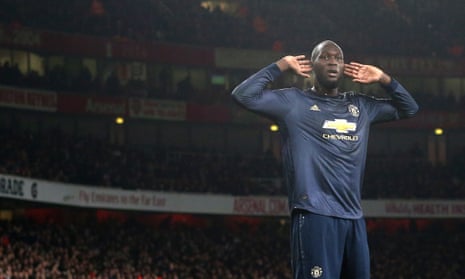Easy game, this management lark. So easy, you wonder what on earth Ole Gunnar Solskjær was doing during his first stint in the Premier League: it didn’t seem this straightforward with Cardiff City. These days, though, it seems he can do no wrong. Not only did he allow Alexis Sánchez to invoke the immutable law of the ex by scoring against Arsenal but, far less expectedly, he deployed Romelu Lukaku to dismantle Arsenal from a position on the right wing.
José Mourinho – and eventually there will be a discussion of Solskjær that doesn’t mention him but not, you suspect, for a while yet – used to have that knack, to the point at times it felt he was tempting the fates to deny his genius. His Porto players speak of feeling that he could read the future. But time moves on and increasingly it seems the most plausible explanation for what has happened at Old Trafford over the past few months is that Mourinho’s deal with dark side expired, the magic ran out and he became cursed, his joyless touch casting Manchester United into an endless sleep from which they could be woken only by the return of a brave young prince from beyond the seas to hack a path through the thickets of confusion, scale the walls of gloom and apply the smiling kiss of life. (An aside: did the hero in Sleeping Beauty really get the girl just by doing some robust gardening?)
Solskjær’s plan at the Emirates on Friday was essentially the same as it had been at Wembley against Tottenham: a 4-4-2 with midfield diamond but with the central strikers split with the result that Jesse Lingard effectively played as a false nine again. Except this time the two strikers, at least until the final quarter of the game, were not the sleekly rapid Marcus Rashford and Anthony Martial, obviously adept at getting in behind the opposing full-backs, but the far less likely figures of Lukaku and Sánchez.
There are numerous reasons why Sánchez’s move to Old Trafford has not (yet) worked out, but the one most damning of United has always been the question of how he and Lukaku were ever supposed to play together.
Lukaku has tended to be seen as a heritage item, a throwback No 9, a bustling figure in the Nat Lofthouse mould, somebody who should have been able to do for Mourinho what Didier Drogba did for him. It may be that image isn’t entirely accurate, that his physique leads him to be slightly miscategorised – much as Frank Stapleton was for much of his time at Old Trafford – and that he is actually a more subtle player than that.
In recent years, at least for Chile and with Arsenal, Sánchez has been at his best drifting in from the left, neither a winger nor a centre forward but something in between, a bustling ghost of the half-space, always looking to zip into the gaps left by a mobile striker. The problem was that Lukaku, used as a target man, wasn’t leaving that space. He does not naturally drop off the front line, operating, in the Mourinho designation, up against the defensive line with his back to goal, meaning Sánchez’s natural avenue of attack was blocked.
The solution, it turns out, was simply not to play Lukaku as a No 9. For a player so apparently uncomfortable dropping deep in a central role, he is remarkably adept coming in off the right flank. He had already devastated Arsenal once doing that, in Everton’s 3-0 league win over them in April 2014, and more recently excelled in that position as Belgium beat Brazil in the World Cup.
Then too he essentially played a game of chicken with the opposing left-back, remaining high, not really tracking so that he always offered an outlet on the break. It’s a risk, of course, allowing free rein to the opposing full-back, be it Marcelo or Sead Kolasinac, and that was a contributory factor in Arsenal’s goal, but that’s the gamble. Here it clearly worked, producing two goals for the one it cost. The second was a classic break down the right flank, but the first was perhaps even more promising, both forwards coming in off their flanks, one to create and one to score, Sánchez relishing the fact there was space to move into as Lukaku found himself naturally deeper.
Rashford and Martial clearly remain the first-choice pair, their absence here for reasons of rotation and squad-management rather than tactics, and the confidence they projected as they came off the bench to finish the job was almost palpable. As Solskjær knows perhaps better than anybody, though, having your third- and fourth-choice forwards fit and firing can be vitally important.
And so his charmed reign goes on; his side hasn’t even been behind yet. It cannot, surely, keep on being quite as trouble-free, his touch cannot remain quite so assured. But for now, Solskjær is on his throne, the sun is shining, the princess is awake, the snows are melting, flowers are blossoming across the land. Taking over from the golden caretaker is beginning to look a daunting task.

